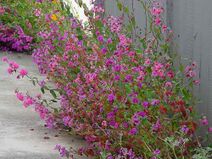Clarkia unguiculata
| Clarkia unguiculata | |
 | |
| Light: | |
| Moisture: | |
| Soil pH: | 5.6-8.4 |
| Height: | 2' |
| Blooms: | Early Summer-Mid Fall |
| Native to: | |
| Shelter Nectary | |
| Edible Rating: | |
| Tea: | Yes |
Clarkia unguiculata (common names: elegant fairyfan and elegant clarkia)
Propagation: Seed - sow spring in situ. The seed usually germinates in 2 weeks[1]. Seed can also be sown in situ during the autumn in mild winter areas[1][2]. Thinnings can be transplanted[1].
Cultivation: Succeeds in a sunny position in any good garden soil[1]. If the soil is too rich the plants will produce lots of vegetative growth at the expense of flowers[3]. Resents hot, humid continental summers[2].
A polymorphic species[2].
A very ornamental plant[1].
The flowers are very attractive to bees[4].
Range: South-western N. America - California.
Habitat: Dry slopes in the chaparral[1].
Edibility: Seed - raw or cooked. It can be ground into a powder and eaten dry[5][6]. The seed is very small and fiddly to harvest.
Usage: Green and gold dyes are obtained from the flowers[7].
Pollinators: Bees
Soil: Can grow in light, medium, and heavy soils.
Drainage: Prefers well drained soil.
Seed Ripens: Late Summer-Mid Fall
Flower Type: Hermaphrodite
Also Known As: C. elegans. Dougl.
Links
References
- ↑ 1.0 1.1 1.2 1.3 1.4 1.5 Chittendon, Fred. RHS Dictionary of Plants. Oxford University Press, 1951.
- ↑ 2.0 2.1 2.2 Huxley, Anthony. The New Royal Horticultural Society Dictionary of Gardening. MacMillan Press, 1992.
- ↑ Brickell, Christopher. The RHS Gardener's Encyclopedia of Plants and Flowers. Dorling Kindersley Publishers, 1990.
- ↑ International Bee Research Association. Garden Plants Valuable to Bees. International Bee Research Association, 1981.
- ↑ Sweet, Muriel. Common Edible and Useful Plants of the West. Naturegraph Co, 1962.
- ↑ Moerman, Daniel. Native American Ethnobotany. Timber Press, 1998.
- ↑ Grae, Ida. Nature's Colors. MacMillan Publishing, 1974.